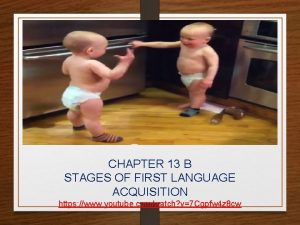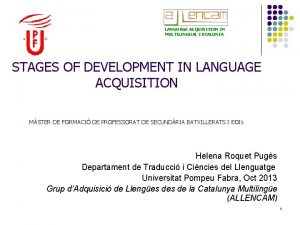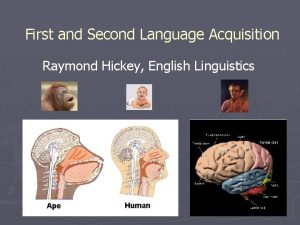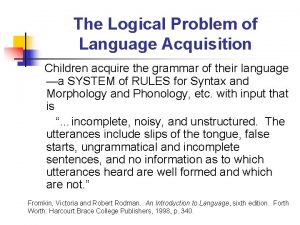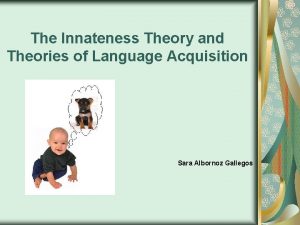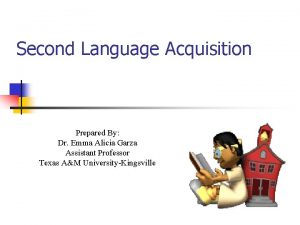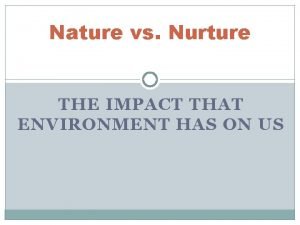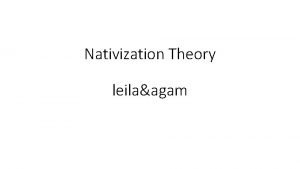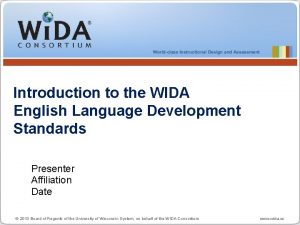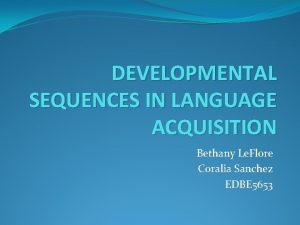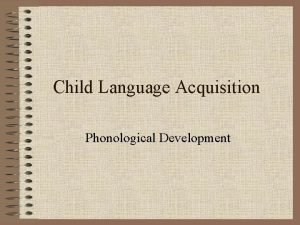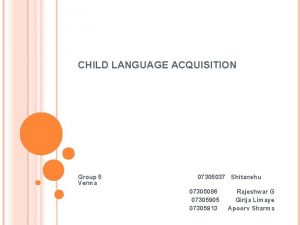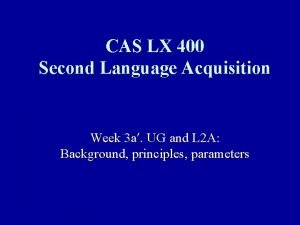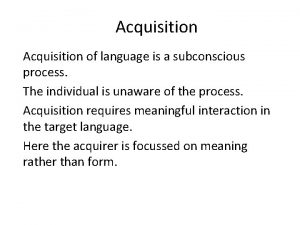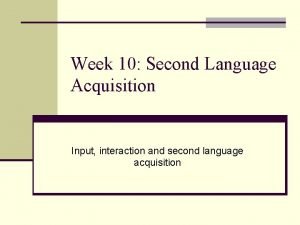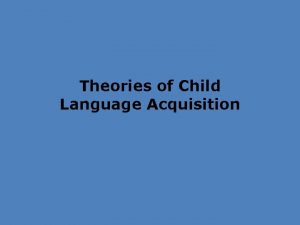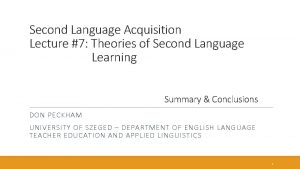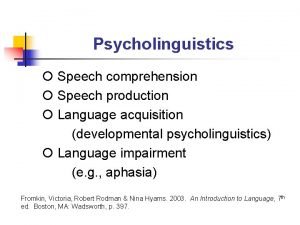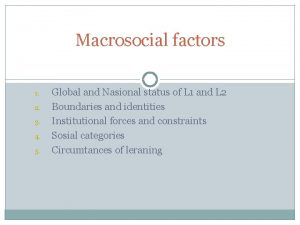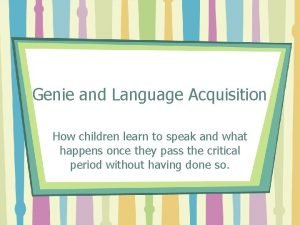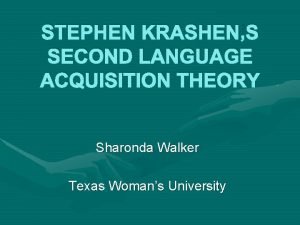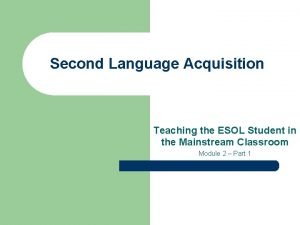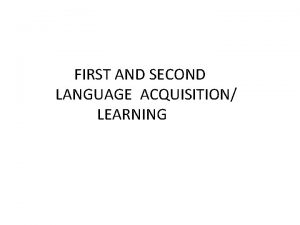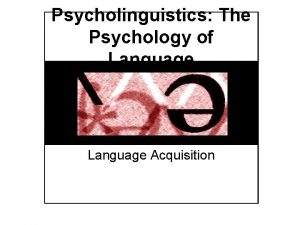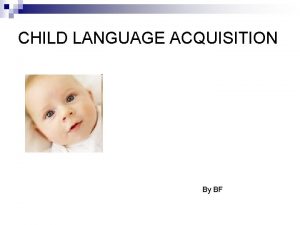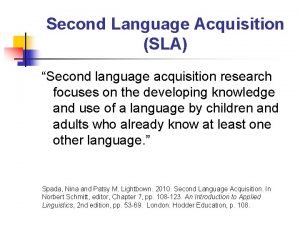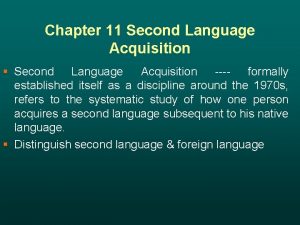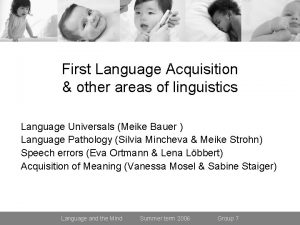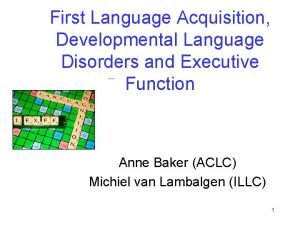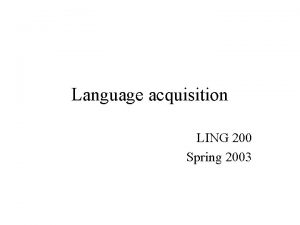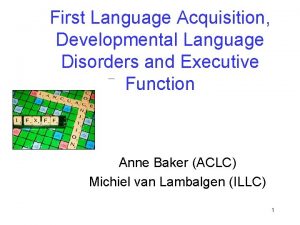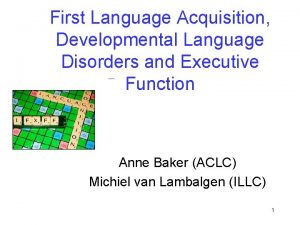First language acquisition of Information structure the acquisition









































































- Slides: 73

First language acquisition of Information structure: the acquisition of topic and focus in French (Fla. CIS) (BOF C 14/15/021) Joint degree with the University of Lille Supervisors: Karen Lahousse (KU Leuven) Emmanuelle Canut (University of Lille) Co-supervisor: Cécile De Cat (University of Leeds)

The Ph. D in a nutshell

Why study the acquisition of clefts and dislocation? • Hypothesis: Information Structure present from the onset of language production Need to study constructions with specific IS properties: o Clefts focus o Dislocation topic • Frequent in spoken language, and syntax and IS properties well documented in adult French, but not in child French (Dislocation: Barnes 1985, Blasco-Dulbecco 1999, De Cat 2002, 2007, Horváth 2016, 2018, etc. ; Clefts: Destruel 2012, 2013, Dufter 2008, 2009, Karssenberg 2018, Karssenberg and Lahoussee 2018 a, 2018 b, Lahousse and Lamiroy, 2017, etc. ) • L 1 acquisition of IS is a trending topic, fast growing literature (Arnhold et al. , 2016, Chen A. 2010, 2011, Chen H. et al. 2018, Lobo et al. 2016, Manetti and Belletti 2017, 2018, etc)

Why study the acquisition of clefts and dislocation? • Most current research on L 1 acquisition of IS = experiments, hence: o Less context, only question/answer settings… Some aspects or properties of IS might be overlooked o Usually children vs. adults, or young vs. older children Studies do not really look at developmental paths between age groups o Difficult to design experiments for children below age 3 Cannot investigate the very beginning of the development of IS

Goals of this study • Investigate the acquisition of topic- and focus-marking constructions from the beginning of their acquisition (1) Mais Maman elle dit non (Marion, age 2, TCOF) ‘But Mom she says no’ (2) C’est moi qui écris (Antonin, age 2, TCOF) ‘It’s me who writes’ • Qualitative and quantitative corpus analysis

Goals of this study • Dislocation o Developmental study of dislocation o What determines the position of the dislocated element in child speech? • Comparison children and adult LD and RD (i) Do children have LD and RD at the same frequency as adults? (ii) Do they use them in the same context? Multinomial regression model • o Syntax and IS What triggers the use of dislocation vs. Simple subject?

Goals of this study • Clefts o Developmental study of clefts o Which IS articulations are acquired first? o Comparison c’est vs. il y a clefts o What triggers the production of full vs. Reduced clefts? Ordinal regression model

Structure of this presentation Part 1: Dislocation 1. 1 Background: dislocation in French 1. 2 Syntactic and IS properties of children’s dislocation 1. 3 Left- vs. Right-dislocation in child language: a multinomial regression model 1. 4 Dislocated vs. Non-dislocated subjects Part 2: Clefts 2. 1 Background: clefts in French 2. 2 Information structure properties of early clefts 2. 3 Interaction between Information Structure and syntax 2. 3. 1 C’est vs il y a clefts 2. 3. 2 Reduced, attempts and full clefts = an ordinal regression model Part 3: General conclusion

Part 1: Dislocation

1. 1 Dislocation in French - adults • Constituent in the left or right periphery of a sentence = topic • In most cases: referent repeated by a clitic pronoun (1) [Ces romains] i , je ne [les] i aime pas. (Lambrecht 1981) These romans I neg them like not. These romans, I don’t like them. • (2) [Ils] i sont fous, [ces romains] i They are crazy, these romans (Lambrecht 1981)

1. 1 Dislocation in French - adults • Dislocation= used for topic • Definition of Lambrecht (1994) o Sentence topic (NOT discourse topic) o Topic = previously established entity about which the speaker conveys information (see also Reinhart 1982) o Statement pragmatically presupposed that the topic entity is “a matter of current interest and concern” (Strawson, 1964) (3) a. (What did the children do next? ) The children went to school. b. (Who went to school? ) The children went to school. c. (What happened? ) The children went to school. (Lambrecht 1994, p. 121)

1. 1 Dislocation in French - adults LD RD Dislocated element More lexical NPs More pronouns Referent • + new in the discourse • + old in the discourse • Less accessible for the • + accessible hearer: • Active in discourse • Shared knowledge • Inferable referent Type of IS function • Contrastive topic • New topic relations Topic maintenance (Horvath 2018, 2016, De Cat 2007, Ashby 1988, Lambrecht 1981) Also interaction functions (De Stefani & Horlacher 2017, De Stefani 2007, Pekarek Doehler, De Stefani & Horlacher 2015)

1. 1 Dislocation in French - children • De Cat (2002, 2004, 2007, 2009): early dislocations in French encode the topic • Belletti and Manetti (2018), Manetti and Belletti (2017): Italian children also use dislocation to code the topic • Generally, large body of literature shows that fairly early on, syntactic constructions encode adult-like IS configurations (Arnhold, Chen and Jarvikivi 2016, Dyakonova, 2004…) What about the more precise properties of topics in left vs. right dislocation?

1. 2 Syntactic and IS properties of children’s dislocation Corpus analysis o TCOF transversal corpora (Project TCOF, ATILF) • 96 children between age 2 and 7 • 1469 dislocations extracted o CHILDES longitudinal corpora • Corpus Lyon: 3 children between age 1, 5 and 2, 5 • 40 hours of recordings per child • 704 dislocations extracted

1. 2 Syntactic and IS properties of children’s dislocation – position of the dislocated element (TCOF corpus) N°of left dislocations N° of right dislocations (RD) (LD) Age Total number of dislocations Abs. Freq. % 2 98 63 58 37 156 100 3 309 76 96 24 405 100 4 277 77 82 23 359 100 5 256 83 53 17 307 100 6 128 95 7 5 135 100 7 130 96 6 4 136 100 1198 80 302 20 1500 100 Total Decrease of the proportion of RD through time (significant p<. 01, Chi²)

1. 2 Syntactic and IS properties of children’s dislocation – syntactic category 120% 100% 80% 60% 40% 20% 0% 2 3 Lexical NP 4 Strong personal pronouns 5 6 demonstrative pronoun 7

1. 2 Syntactic and IS properties of children’s dislocation – syntactic category • Chi² test • Higher proportion of lexical NP in RD, and of pronouns in LD • Significant results between age 2 and 5 Age group X p-value Cramer’s V 2* 12. 0179 <. 01 0. 2767 3* 11. 9388 <. 01 0. 1717 4* 11. 8291 <. 01 0. 1813 5* 4. 0478 <. 05 0. 1148 <. 6 / <. 114 / 6 7 0. 2662 2. 4949

1. 2 Syntactic and IS properties of children’s dislocation – resumptive expression

1. 2 Syntactic and IS properties of children’s dislocation – resumptive expression • Higher proportion of subjects in LD and of objects in RD • Significant between age 3 and 5 Age group X p-value Cramer’s V 2 1. 1788 P<. 278 / 3* 9. 2514 P<. 01 0. 1511 4* 30. 2368 P<. 01 0. 2898 5* 38. 8972 P<. 01 0. 356 6 / / / 7 / / /

1. 2 Syntactic and IS properties of children’s dislocation - Accessibility • Mentioned, no competitors (3) Adult: Pourquoi t’aimes pas les fleurs? “Why don’t you like flowers? ” Child: Parce que c’est pas gentil, les fleurs. “Because flowers are not nice” (Charlotte, age 2) (4) Toi tu joues à ça. ‘You, you play with that’ (Antonin, age 2) • Mentioned, competitors (5) Papa crie Juliette parce que le bébé il a fait caca. (Marianne, age 2) ‘Dad shouted Juliette because the baby he pooped’

1. 2 Syntactic and IS properties of children’s dislocation - Accessibility • Bridging : Discourse-new but semantic link with a previously mentioned entity (6) Adult: et à l'école tu fais du coloriage ? ‘Do you colour at school? ’ Child: Non, jamais. ‘No, never’ Adult: Jamais? Child: La maîtresse elle veut pas. ‘The teacher doesn’t want’ (Laureen, age 4) • Situationally given : Discourse-new but physically present (7) ça c’est quoi? ‘What is that? ’ (Héloïse, age 2)

1. 2 Syntactic and IS properties of children’s dislocation - Accessibility 120% Mentioned, no competitor 100% Mentioned, competitors 80% Situationally given 60% Bridging 40% Shared knowledge 20% Brand New 0% 2 3 4 5 6 7 • Decrease of situationally given referents • Increase in bridging No significant difference between LD and RD

1. 2 Syntactic and IS properties of children’s dislocation – Function • Topic maintenance : same sentence topic as in the preceding utterance (8) Adult: c'est des algues rouges et Arc-En-Ciel il prend les algues ‘This is red seaweed and Rainbow, he takes the seaweed’ Child: Pourquoi Arc-en-Ciel il prend les algues? ‘Why does Rainbow take the seaweed? ’

1. 2 Syntactic and IS properties of children’s dislocation – Function • Topic reactivation: the referent was topic in a preceding utterance (9) Child: alors maintenant faut trouver Bambi. Là on peut jouer et Nicolas il faut pas qu’il entende lui. ‘So now we must find Bambi. Now we can play and Nicolas, he shouldn’t hear. ’ Adult: non. ‘No’ Child: Bon Bambi où est-ce qu’elle est elle? ‘Well Bambi, where is she? ’ (Laurie, age 4)

1. 2 Syntactic and IS properties of children’s dislocation – Function • Promotion to topic: referent is active, but in focus in previous mention (10) Child: Maintenant, il faut trouver l’éléphant. Où est-ce qu’il est, l’éléphant? ‘Now, we must find the elephant. Where is it, the elephant? ’ (Laurie, age 4) • Select topic from group: the referent is mentioned within a group of active referents (11) Ils font des bêtises. Lui, il a attrapé le poisson. ‘They are doing mischief. Him, he cought the fish. ’ (Kelly, age 3)

1. 2 Syntactic and IS properties of children’s dislocation – Function • Focus! (12) Child: bah on il y a plein de jeux par exemple il y a un il y a des i- il y a les mots croisés faut les trouver. Ça c’est facile. Adult: tu joues toute seule ou avec des autres ? Child : maman quelque fois elle m’aide. (Flavie, age 6) Child : ‘Well we there a lot of games, for example there is a some there is the crosswords, you need to find them. That, it’s easy. ’ Adult: ‘you play alone or with others? ’ Child: ‘My mom sometimes she helps me’

1. 2 Syntactic and IS properties of children’s dislocation – Topic relation 100% Topic maintenance 90% 80% Reactivation topic 70% Promotion to topic 60% 50% Accessible to topic 40% Select topic from group 30% 20% Focus 10% 0% 2 3 4 5 6 7 • Main functions: reactivation + accessible referent as topic (prototypical in adult speech) • Few non-adult like functions

1. 2 Overview of the data - Contrast • More frequent than in adult speech : between 20 and 45% of LD depending on the age group (between 21 and 24% of adults’ LD, Ashby 1988) • Contrast : significant impact on the place of dislocated element for all age groups: contrast more in LD (13) Moi je joue à ça et toi tu joues à ça. Me, I play with that and you, you play with that. (Antonin, age 2, 5, TCOF)

1. 3 LD vs. RD: a multinomial regression model • Used the multinom() function in R • Included contrast, syntactic properties, accessibility, topic relation and age in months as factors Accessibility: only non-significant factor • Final model: multinom(Direction 2 ~ Age. month + contrast+ Syntactic. category+ Syntactic. function+ Topic. relation)





1. 3 LD vs. RD: a multinomial regression model • Contrast : acquired early by children, adult-like production of contrastive dislocated topics (in LD) • Syntactic category : Lexical NPs seem harder to process than pronouns for children (Arnon 2010) • Syntactic function : children seem to prefer the canonical word order, even in constructions that do not require it (Diessel and Tomasello, 2005) • Function: seems to follow adults’ data: more topic maintenance in RD (Horvath 2018, 2016) • Age : also significant factor

1. 4 Dislocated vs. Non-dislocated subjects • Child French : dislocation + frequent than in adult data (Gotowski, 2015; Parisse, 2008) • Parisse (2008): maybe + dislocation in child data, because dislocation is used for processing reasons o Used when the subject is long o Dislocation cuts the sentence into two parts • Legendre et al. (2010) & Gotowski (2015): children interpret clitic pronouns as agreement markers Produce dislocation systematically with lexical subjects

1. 4 Dislocated vs. Non-dislocated subjects • In section 1. 3 = Children’s dislocation have adult-like IS properties Maybe more dislocation in child language because they produce more utterances with IS properties requiring dislocation? • Compare dislocated vs. non-dislocated subjects o Study done on 21 children between age 2 and 5 from TCOF o Subset of children of the corpus due to the high number of nondislocated subjects o Separate analyses for pronoun and lexical subjects (because different IS properties)

1. 4 Dislocated vs. Non-dislocated subjects - distribution Subject types across age groups 100% 90% 80% 70% 60% 50% 40% 30% 20% 10% 0% 2 2. 5 NDS pronoun 3 3. 5 NDS lexical 4 DS pronoun • 1246 non-dislocated and 395 dislocated subjects • Almost all lexical subjects = dislocated (except 8 cases) • Most subjects =non-dislocated pronouns 4. 5 DS lexical 5

1. 4 Dislocated vs. Non-dislocated subjects - pronouns • Difference in accessibility of pronoun NDS and DS o Pronoun DS = 27% are situationally given o Pronoun NDS = only 3% are situationally given • Difference in contrast o Pronoun DS = 48% contrastive topic o Pronoun NDS = no clear case of contrastive topic

1. 4 Dislocated vs. Non-dislocated subjects – lexical subjects • Lexical NDS are extremely rare in our corpus (8 cases), so it is more difficult to analyze. • All 8 cases are all-focus utterances (14) or in narration (15) (14) Une fois, une vieille sonna à la porte. (Adeline, age 5) One day, an old woman rang at the door se (15) Context: the child and the adult are looking at a picture book together, and the child is trying to tell the story Oui, dans cet immeuble, il y avait la nuit qui commence. La mère meta à le suivre. (Baptiste, age 3, 5) Yes, in that building, there is the night that’s starting. The mother started to follow him.

1. 4 Dislocated vs. Non-dislocated subjects – lexical subjects • Research on adult French: lexical NDS all-focus utterances (Lambrecht, 1994, De Cat, 2002, 2007) Explains why lexical NDS in all-focus and in narration in children’s speech

1. 4 Dislocated vs. Non-dislocated subjects – conclusion • NDS and DS have different properties: o NDS tend to be more accessible than DS o Contrastive topics only in DS o Lexical NDS tend to belong to all-focus utterances, which seem restricted to narrative contexts in our data • Lexical NDS: very specific IS and discourse properties Difficult to claim that lexical subjects are dislocated for processing reasons or because interpret the pronoun as an agreement marker

Conclusion of part 1

Conclusion part 1 - Dislocation • The position of the dislocated element is influenced by: o Syntactic factors (processing reasons) • Syntactic category (more NP in LD vs. more pronouns in RD) • Syntactic function (more subjects in LD vs. more objects in RD) o IS factors • Contrast (contrastive topics in LD) • Type of topic relation (Topic maintenance in RD)

Conclusion part 1 - Dislocation • The position of the dislocated element in child language is determined by o adult-like factors = Information Structure properties o child-specific factors = processing • Dislocated and non-dislocated subjects = different IS properties Dislocation = probably not just used for processing reasons

Part 2: Clefts

2. 1 Clefts in French - Adults • Clefts = o o Two clauses: matrix clause + relative clause One semantic proposition • Different introductory expressions (among others) C’est Morgane qui écrit une thèse sur l’acquisition des clivées. It’s Morgane who writes a thesis on the acquisition of clefts o Il y a quelqu’un qui toque à la porte. There is someone who’s knocking on the door. o

2. 1 Clefts in French - Adults • Can have different IS articulations (Following Lambrecht’s terminology) o Focus-background • Focus= part of the utterance whose information differs from the presupposition New information • Background: presupposition (16) A: Qui écrit une thèse sur l’acquisition des clivées? Who’s writing a thesis on the acquisition of clefts? B: C’est Morgane qui écrit une thèse sur l’acquisition des clivées It’s Morgane who’s writing a thesis on the acquisition of clefts.

2. 1 Clefts in French - Adults o All-focus The entire sentence conveys new information (17) A: Tu as l’air inquiète. Qu’est-ce qui se passe? You seem worried. What happened? B: C’est le petit qui est tombé dans l’escalier. It’s the kid who fell down the stairs. (Clech-Darbon et al. , 1999)

2. 1 Clefts in French - children Hupet & Tilmant (1989) • Elicited production experiment / ages 4 – 10 • French children produce subject clefts more easily than object clefts, even at age 10 De Cat (2002) • Observations in corpus of spontaneous production (ages 1; 10 and older) • Some early attempts of reduced clefts = main clause + right dislocation (as from 1; 11) (18) Non c’est moi, (qui l’ai) le pingouin (Tom 2; 1. 11) ‘No it’s me (who has it) the penguin’

2. 1 Clefts in French - children Canut (2014) • Appearance and frequency with respect to other (complex) sentence types • C’est … qui / que … sentences appear at age 2, and increase in frequency until age 5 • But: o No distinction between clefts >< ‘cleft lookalikes’ (c’est + NP + restrictive relative clause) o No data on reduced clefts Belletti (2005) • Some examples of reduced clefts from Childes (as from age 2; 1) • Reduced clefts (as an answering strategy) “are in place early on, as soon as the first felicitous conversational exchanges can be documented”.

2. 2 Information structure properties of early clefts Discourse interpretation of adult c’est clefts: • Corrective focus (correct a previously given referent) • Contrastive focus (pick one out of alternatives) • New info focus • Very limited instances of broad focus • Cohesive clefts (clefted element = topic/frame, CRC = comment) • “Double contrast” (- C’est Pierre qui chante? – Non, c’est Jean qui crie. ) Children’s early c’est clefts in our data: Same discourse interpretations (in all syntactic types of CRC)

2. 2 Information structure properties of early clefts • Restrictive focus (with focus particle)-background (19) Adulte: Juliette ? elle est en train de jouer avec euh la maîtresse aux marionnettes Hugo: Hum Adulte: tu sais les marionnettes tu les mets dans les mains Hugo: Hum et moi je le mets pas c'est que maîtresse qui met dans les mains (Hugo, age 3, TCOF)

2. 2 Information structure properties of early clefts New information focus + background (20) Adult: Ah oui ça il faut mettre des casques parce que alors quand on tombe on se fait mal à la tête hein ? + oh Alexandre: ben moi une fois ben ma Maman elle a pas *** un casque Adult: elle avait pas de casque ? Alexandre: non elle est tombée Adulte: elle s'est fait mal ? Alexandre: ouais elle était à l'hôpital Adulte: ah à l'hôpital Alexandre: c'est moi qui l'ai amenée (Alexandre, 3)

2. 3 Interaction between Information Structure and syntax C’est and il y a clefts • Different distribution of IS articulations between c’est and il y a clefts • C’est clefts can be: o Focus-background (frequent) o Topic-comment (frequent) o All-focus (rare) • Il y a clefts can be: o All-focus (83% of il y a clefts, Karssenberg 2018, Karssenberg & Lahousse 2018) o Focus-background (16%, Karssenberg 2018, Karssenberg & Lahousse 2017, 2018 a, 2018 b)

2. 3 Interaction between Information Structure and syntax C’est and il y a clefts IS articulations of c'est clefts in the TCOF corpus 40 35 30 25 20 15 10 5 0 2 3 4 5 6 7 8 Focus-background All-focus Topic-comment Double focus Reduced clefts Ambiguous 9 10

2. 3 Interaction between Information Structure and syntax C’est and il y a clefts IS articulations of il y a clefts in the TCOF corpus 10 9 8 7 6 5 4 3 2 1 0 2 3 All-focus 4 Focus-background 5 6 Reduced clefts 7

2. 3 Interaction between Information Structure and syntax C’est and il y a clefts • Children use constructions with adult-like IS articulations • Children tend to initially produce the more “prototypical” IS articulation o C’est clefts = initially more focus-bakcground o Il y a clefts = initially more all-focus

2. 3 Interaction between Information Structure and syntax Reduced vs. Full clefts • Younger children acquiring European Portuguese = produce more reduced clefts (without relative clause) than full clefts (Lobo et al. , 2016) Investigate whether this is the same in French Investigate the factors of production vs. omission of the relative clause • Study on the longitudinal corpus of Lyon (Demuth and Tremblay, 2008) o 3 children between age 1 and 3 o 120 reduced clefts, 73 cleft attempts, 59 full clefts o First cleft attempts are produced at the same age as first reduced clefts Which factors lead to the production of cleft attempts or reduced clefts?

2. 3 Interaction between Information Structure and syntax Reduced vs. Full clefts • Include factors that may lead to the relative clause being produced or omitted o accessibility of the relative clause o contrastive nature of the clefted element

Coding of the accessibility of the omitted / trial / full relative clause o discourse-old (21) Adult: Qui c’est qui a accroché le ballon dessus? ‘Who hanged the balloon on it? ’ Child: C’est Chloé. ‘It’s Chloé’ (Anaïs, 2; 7. 12) o part of the “cognitive frame” (= different action, but part of the same general event) (22) (The mother and the child are looking at a book together) Child: C’est moi tourne la page. ‘It’s me turn the page’ (Anaïs, 2; 9. 29)

Coding of contrastive nature of the clefted element o explicit mention of an alternative in the discourse (23) Adult: (ç)a y est c'est moi qui m'assois sur ton fauteuil ! ‘Here we go, it’s me who is sitting on your armchair!’ Child: non c’est moi! ‘No it’s me’ o implicit alternative in the discourse (24) Context: the mother is preparing a sandwich for the child Adult: tu veux d(e) la confiture ou du nutella. ‘you want jam or nutella? ’ Child: du nutella Adult: du nutella Child: oui. C’est moi y coupe. ‘It’s me I cut’

Analysis • Ordinal regression model predicting the type of cleft produced (i. e. how much of the embedded clause is realised). • Predictors tested for: o o MLU Child Accessibility of the embedded clause Contrastiveness of the focus Significant interaction between MLU and Accessibility (at higher MLU, less accessible “events” tend to be realised more as full embedded clauses) Significant effect of Contrastiveness

Accessibility = full cleft = reduced cleft

Accessibility • Similar trends across children • The (non)-accessible nature of the (implicit / trial / full) CRC does not have a significant effect (but our power is low) on the presence / absence of the CRC & its syntactic type (reduced cleft / cleft trial / full cleft)

Contrast = full cleft = reduced cleft

Contrast • Again: more or less same tendency for each child (independently of individual development through time) • The embedded clause is more likely to be realized as a full clause when the focus is contrastive. ÞIf the clefted element is non-contrastive => more likely to be a full CRC ÞIf the clefted element is contrastive => less likely to be a full CRC

Conclusion of part 2

2. Clefts - Conclusion • From the onset of production of (reduced) clefts o adult-like IS => IS present before adult-like syntax of clefts? • Children produce il y a and c’est clefts with adult-like IS articulations o C’est clefts • more focus-background (especially beginning) • Topic-comment and all-focus o Il y a clefts • Start with mostly all-focus • Focus-background in specific contexts

2. Clefts - Conclusion • Some factors have an impact on the type of cleft (reduced/attempt/full), i. e. type of the CRC o Ordinal regression model in R o Contrast: significant • Non-contrastive clefts = more likely to have a complete CRC • Contrastive clefts = less likely to have a complete CRC o Accessibility: not significant • Higher proportion of complete CRC if content of the CRC = less accessible • Higher proportion of reduced clefts if content of the CRC = more accessible • Lack of significance might be due to a small dataset

Part 3: General conclusion

3. General conclusion • Children = sensitive to IS articulations of constructions from the start (as suggested in former research on the acquisition of IS in child language) o Dislocation = topic-comment o Clefts = focus-background, all-focus, and topic-comment Development of syntax and IS go hand in hand

3. General conclusion • Children are sensitive to more fine-grained IS concepts Accessibility Children use dislocations with less accessible subjects, and nondislocated pronouns with highly accessible subjects o Topic maintenance vs. establishment of a new topic More RD with topic maintenance, more LD with establishment of a new topic o o Contrast • Contrastive topics in LD, rather than RD • Effect of contrast on the production of the relative clause in clefts

Thank you!
 What is language acquisition
What is language acquisition Systematicity and variability in first language acquisition
Systematicity and variability in first language acquisition First language acquisition stages
First language acquisition stages Psychomotor considerations language acquisition
Psychomotor considerations language acquisition Corso di laurea in scienze della formazione primaria
Corso di laurea in scienze della formazione primaria Difference of first language and second language
Difference of first language and second language Language
Language Defense acquisition management information retrieval
Defense acquisition management information retrieval Hát kết hợp bộ gõ cơ thể
Hát kết hợp bộ gõ cơ thể Slidetodoc
Slidetodoc Bổ thể
Bổ thể Tỉ lệ cơ thể trẻ em
Tỉ lệ cơ thể trẻ em Gấu đi như thế nào
Gấu đi như thế nào Tư thế worm breton
Tư thế worm breton Chúa yêu trần thế alleluia
Chúa yêu trần thế alleluia Môn thể thao bắt đầu bằng chữ đua
Môn thể thao bắt đầu bằng chữ đua Thế nào là hệ số cao nhất
Thế nào là hệ số cao nhất Các châu lục và đại dương trên thế giới
Các châu lục và đại dương trên thế giới Công thức tiính động năng
Công thức tiính động năng Trời xanh đây là của chúng ta thể thơ
Trời xanh đây là của chúng ta thể thơ Mật thư tọa độ 5x5
Mật thư tọa độ 5x5 101012 bằng
101012 bằng độ dài liên kết
độ dài liên kết Các châu lục và đại dương trên thế giới
Các châu lục và đại dương trên thế giới Thể thơ truyền thống
Thể thơ truyền thống Quá trình desamine hóa có thể tạo ra
Quá trình desamine hóa có thể tạo ra Một số thể thơ truyền thống
Một số thể thơ truyền thống Cái miệng xinh xinh thế chỉ nói điều hay thôi
Cái miệng xinh xinh thế chỉ nói điều hay thôi Vẽ hình chiếu vuông góc của vật thể sau
Vẽ hình chiếu vuông góc của vật thể sau Nguyên nhân của sự mỏi cơ sinh 8
Nguyên nhân của sự mỏi cơ sinh 8 đặc điểm cơ thể của người tối cổ
đặc điểm cơ thể của người tối cổ Ví dụ về giọng cùng tên
Ví dụ về giọng cùng tên Vẽ hình chiếu đứng bằng cạnh của vật thể
Vẽ hình chiếu đứng bằng cạnh của vật thể Vẽ hình chiếu vuông góc của vật thể sau
Vẽ hình chiếu vuông góc của vật thể sau Thẻ vin
Thẻ vin đại từ thay thế
đại từ thay thế điện thế nghỉ
điện thế nghỉ Tư thế ngồi viết
Tư thế ngồi viết Diễn thế sinh thái là
Diễn thế sinh thái là Các loại đột biến cấu trúc nhiễm sắc thể
Các loại đột biến cấu trúc nhiễm sắc thể Số nguyên tố là số gì
Số nguyên tố là số gì Tư thế ngồi viết
Tư thế ngồi viết Lời thề hippocrates
Lời thề hippocrates Thiếu nhi thế giới liên hoan
Thiếu nhi thế giới liên hoan ưu thế lai là gì
ưu thế lai là gì Khi nào hổ con có thể sống độc lập
Khi nào hổ con có thể sống độc lập Sự nuôi và dạy con của hươu
Sự nuôi và dạy con của hươu Hệ hô hấp
Hệ hô hấp Từ ngữ thể hiện lòng nhân hậu
Từ ngữ thể hiện lòng nhân hậu Thế nào là mạng điện lắp đặt kiểu nổi
Thế nào là mạng điện lắp đặt kiểu nổi Logical problem of language acquisition
Logical problem of language acquisition Theories of language acquisition
Theories of language acquisition Teori second language acquisition
Teori second language acquisition Competence vs performance in linguistics
Competence vs performance in linguistics Similarities of vygotsky's piaget's and chomsky's theories
Similarities of vygotsky's piaget's and chomsky's theories Oxana malaya nature vs nurture
Oxana malaya nature vs nurture What is nativization
What is nativization Language
Language Four theories of language development
Four theories of language development Developmental sequence in language acquisition
Developmental sequence in language acquisition Berko and brown fish
Berko and brown fish What is language acquisition device
What is language acquisition device Language
Language Krashen's 5 hypothesis
Krashen's 5 hypothesis Language learning is a subconscious process
Language learning is a subconscious process Input and interaction in second language acquisition
Input and interaction in second language acquisition Language
Language 7 theories of second language acquisition
7 theories of second language acquisition Comprehension and production in language acquisition
Comprehension and production in language acquisition Macrosocial factors
Macrosocial factors Genie language acquisition
Genie language acquisition Second language acquisition questions
Second language acquisition questions Stephen krashen
Stephen krashen Krashen vs cummins
Krashen vs cummins


